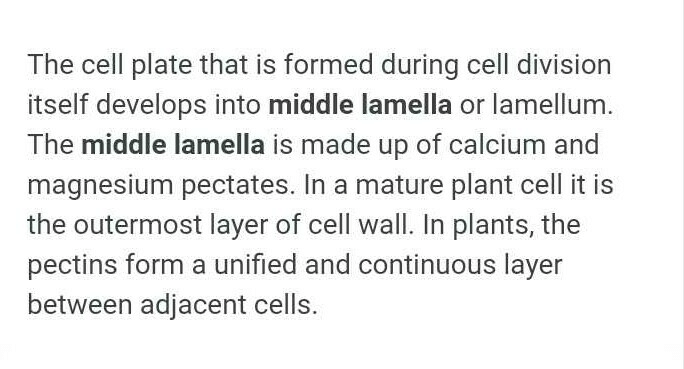NEET Exam > NEET Questions > The middle lamella is composed of :-a)Calcium...
Start Learning for Free
The middle lamella is composed of :-
- a)Calcium pectate
- b)Cellulose
- c)Lignin
- d)Proteins
Correct answer is option 'A'. Can you explain this answer?
Most Upvoted Answer
The middle lamella is composed of :-a)Calcium pectateb)Cellulosec)Lign...

Free Test
FREE
| Start Free Test |
Community Answer
The middle lamella is composed of :-a)Calcium pectateb)Cellulosec)Lign...
The middle lamella is a cementing layer of the plant cell wall that holds together adjacent plant cells. It is usually made of calcium and magnesium pectates.

|
Explore Courses for NEET exam
|

|
Question Description
The middle lamella is composed of :-a)Calcium pectateb)Cellulosec)Lignind)ProteinsCorrect answer is option 'A'. Can you explain this answer? for NEET 2025 is part of NEET preparation. The Question and answers have been prepared according to the NEET exam syllabus. Information about The middle lamella is composed of :-a)Calcium pectateb)Cellulosec)Lignind)ProteinsCorrect answer is option 'A'. Can you explain this answer? covers all topics & solutions for NEET 2025 Exam. Find important definitions, questions, meanings, examples, exercises and tests below for The middle lamella is composed of :-a)Calcium pectateb)Cellulosec)Lignind)ProteinsCorrect answer is option 'A'. Can you explain this answer?.
The middle lamella is composed of :-a)Calcium pectateb)Cellulosec)Lignind)ProteinsCorrect answer is option 'A'. Can you explain this answer? for NEET 2025 is part of NEET preparation. The Question and answers have been prepared according to the NEET exam syllabus. Information about The middle lamella is composed of :-a)Calcium pectateb)Cellulosec)Lignind)ProteinsCorrect answer is option 'A'. Can you explain this answer? covers all topics & solutions for NEET 2025 Exam. Find important definitions, questions, meanings, examples, exercises and tests below for The middle lamella is composed of :-a)Calcium pectateb)Cellulosec)Lignind)ProteinsCorrect answer is option 'A'. Can you explain this answer?.
Solutions for The middle lamella is composed of :-a)Calcium pectateb)Cellulosec)Lignind)ProteinsCorrect answer is option 'A'. Can you explain this answer? in English & in Hindi are available as part of our courses for NEET.
Download more important topics, notes, lectures and mock test series for NEET Exam by signing up for free.
Here you can find the meaning of The middle lamella is composed of :-a)Calcium pectateb)Cellulosec)Lignind)ProteinsCorrect answer is option 'A'. Can you explain this answer? defined & explained in the simplest way possible. Besides giving the explanation of
The middle lamella is composed of :-a)Calcium pectateb)Cellulosec)Lignind)ProteinsCorrect answer is option 'A'. Can you explain this answer?, a detailed solution for The middle lamella is composed of :-a)Calcium pectateb)Cellulosec)Lignind)ProteinsCorrect answer is option 'A'. Can you explain this answer? has been provided alongside types of The middle lamella is composed of :-a)Calcium pectateb)Cellulosec)Lignind)ProteinsCorrect answer is option 'A'. Can you explain this answer? theory, EduRev gives you an
ample number of questions to practice The middle lamella is composed of :-a)Calcium pectateb)Cellulosec)Lignind)ProteinsCorrect answer is option 'A'. Can you explain this answer? tests, examples and also practice NEET tests.

|
Explore Courses for NEET exam
|

|
Signup for Free!
Signup to see your scores go up within 7 days! Learn & Practice with 1000+ FREE Notes, Videos & Tests.























